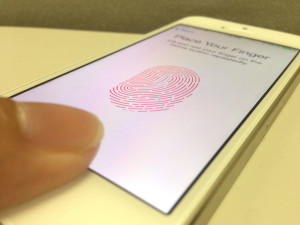This post originally appeared on Andree’s personal blog. You can follow him here @andreehuk.
Apple‘s design goal is to create holistic and consistent experiences. Apple focuses exclusively on devices and services that they can control. In fact, this control actually has likely increased as Walt Mossberg writes about WWDC 2014 on re/code.

picture courtesy Ryan Ozawa
Customers are being enticed more and more to stay within the Apple ecosystem (ideally with more iDevices down the road). However, TouchID will make this holistic experience even more convenient, stickier if you like.
Tim Cook has been big on numbers this past Monday and happily noted that 800 million iOS devices have been shipped to-date. That is be more than half of the Chinese population owning an iOS device. Those are indeed astounding numbers (among others). And more to come.
I do not want to talk specifically about iPhones but more about the much broader picture for TouchID. However, to start painting on the right canvas let us assume (and rightly so) that every new iDevice being sold at the end of this year shall be equipped with a TouchID sensor.
Until June 2nd many people had hoped but were not sure whether Apple will eventually open up TouchID through a public API. Apple will now provide a public TouchID API for every app to access.
We know that Apple aspires to create the most holistic experience across all devices. When I wrote “every iDevice” earlier I actually meant to say every devices that Apple ships. You can easily see that a TouchID sensor will soon appear on every iPad and Mac.
You will then be able to simply hold a finger to unlock even your most stationary laptop computer. Let us jump back and forth between hardware and software here. So, we know what Apple just announced to offer TouchID access for every iOS app. Very soon will see access for every OS X app on desktop as well, probably even Apple’s own Safari and therefore Mobile Safari.
Ideally, they will write an integration that even websites are able to make use of the API on a browser level. Say goodbye to ever enter your login credentials again when accessing websites on desktop and mobile.
Let us continue with the car industry. Apple is currently getting a foothold in the that industry with CarPlay and the cooperation with a handful of car companies, most notably Ferrari and Mercedes-Benz. You can see however that even the laggard’ish car industry is getting slowly infiltrated by Apple.
However upscale the market might be. To get to an iPod-like market penetration Apple would need to snatch a deal with the Volkswagen’s of the world (we’ll see if Toyota will eventually launch a model with CarPlay). Time will tell if the cooperation does bear fruit for the car companies just mentioned and whether people make a clear indication that their car purchase is influenced by the ability to seamlessly use their iPhone (or iOS device for that matter).
BMW Group and Toyota may join as committed partners down the road but since BMW as well as Volkswagen have a technology group in Silicon Valley they are most likely working on their own solutions. If they do aspire to have their own solution they would simply build an that app that allows the car to be opened and “unlocked”.
In any event imagine TouchID being a part of CarPlay or better yet – iCar – down the road. iCar might already well exist but instead of a physical car imagine iCar as an intelligent software solution for every car on the road. I would rather just touch the cars’ door handle instead of looking for the car keys in my jacket or worse yet taking out the iPhone, switching on the flashlight and looking inside my sports bag.
Your Home: With HomeKit, Apple starts building an ecosystem around your very home. It is not hard to imagine a cooperation with the IKEA’s or even the big lock makers of the world for you to be able to access your home, garage or office with your own iPhone. Why would everyone ever want any type of physical key again.
Say goodbye to digital passwords and physical keys. It all started with a phone.


